 |
Only Nuclear Energy Can Solve The World’s Energy Demands
by Henri Safa
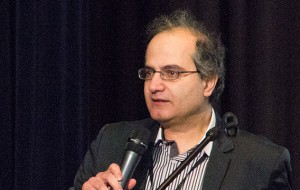 Henri Safa. |
[Query to Christine Schier re names of French towns.]
Prof. Dr. Henri Safa is a French nuclear physicist, author, and international expert in energy density, nuclear engineering and instrumention, and a member of the Science Board of the Nuclear Energy Division of CEA (Atomic and Alternative Energy Commission), France. His speech led the panel on “Energy Security for the 21st Century” at the Schiller Institute conference in Frankfurt am Main, Germany, April 13-14.
Good afternoon. I would like to show you this afternoon why nuclear appears really unavoidable in the long run.
First, if we take an historical perspective, you know that energy has always been important for humanity, and we started using biomass a long time ago. So, biomass was the first source we’ve been using for a very, very long time; and since coal was discovered in the 17th Century in England, it has really changed our world, because it led to the Industrial Revolution that we had in the 18th Century. And afterwards, of course, the discovery of oil in the 19th Century led to the tremendous growth that we had in the world in the 20th Century, and this has eased all transportation in the world.
Afterwards, of course, liquefaction of gas, in 1956, also made a big burst in energy, that we are seeing today in the expansion of energy use.
At the same time, electricity: When we started using electricity at Niagara Falls, it was an astonishing use of transportation of energy over long distances, that can be used easily through only a small wire, a small copper wire. And this has led also to the use of energy over long distances.
And everybody knows that in 1942, Enrico Fermi built his first [atomic] pile in Chicago stadium, and this was very astonishing-that he could, for the very first time, extract energy from uranium. And this was expanded in the late 20th Century.
Energy Doesn’t Disappear
So, just a few basic figures to have in mind about the amount of energy we are talking about: Of course, the official unit is the joule, but the more common unit is kilowatt hours; this is what you use every day. And one kilowatt hour, just to keep things in mind, is 40% of what we eat per day for a human body, but it’s only driving 1 kilometer in a car. So, it’s a fairly good amount of energy.
For example, if we want to go and get a baguette at the bakery, sometimes we are moving 1 ton of metal over several kilometers, just to have this movement of 250 grams. One point I wanted to stress here, is efficiency of using our energy sources. And this is very important.
Figure 1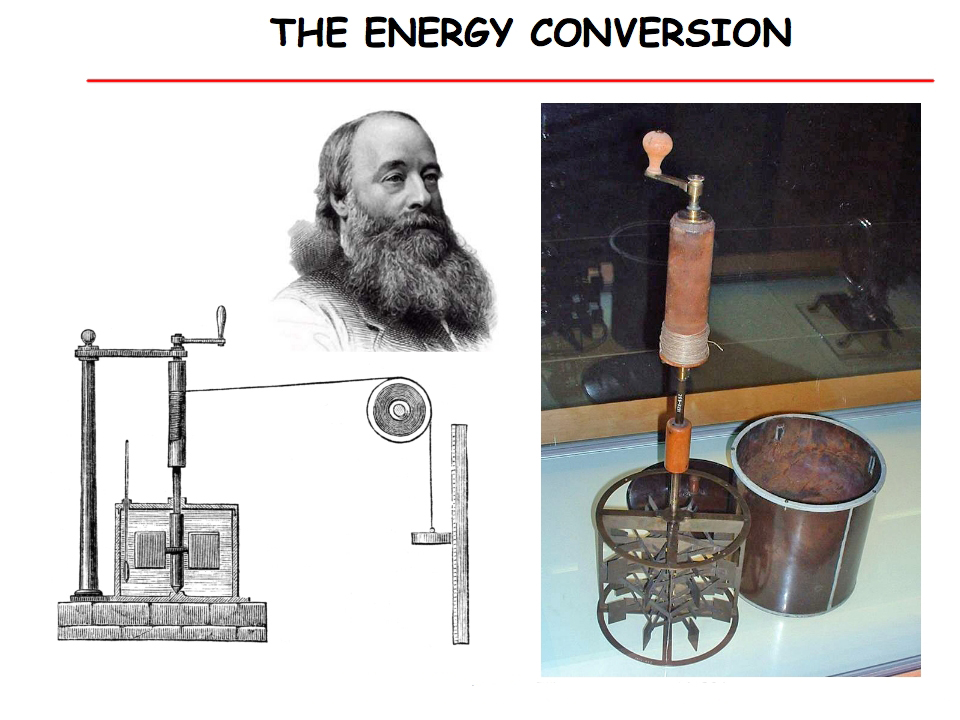 |
Another thing that has been discussed over the centuries, especially by James Joule, is that energy, in fact, doesn’t appear from nothing (Figure 1). We only convert energy from one form of energy to another. So, energy doesn’t disappear. Energy is a conservative physical unit, and what we are doing when we are using energy, is that we are just moving one form of energy to another form of energy. And this is what Joule showed with his small apparatus here, where he had the small mass here, falling with gravity, and this mass is connected to a small water loop, where we have a pail rotating in the water. He showed that energy from gravity is transformed into heat energy in the water. And he measured the temperature. And this is how he determined that we need 4.4 joules to heat one gram of water by one degree. And this means that, after that, the idea has been to convert energy from one form to another, and we have invented a lot of techniques to convert one form of energy to another.
Of course, we have thermal energy, we have chemical energy, electrical energy, mechanical energy, and radiation energy, nuclear, and hydraulics. For example, when you are using lighting, when you have a lamp, you’re taking electrical energy in a resistor, you’re heating the resistor, going to thermal energy, and then this thermal energy is at a sufficiently high temperature to have radiation energy. So you’re moving from this part, to this part, to this part.
When you’re doing that, the overall efficiency, going from electrical energy to radiation energy, is only 2%. So this means that you’re losing 98% in this process! And this is why it’s important to have efficiency in the process.
When you are using nuclear energy, you’re going from nuclear material to fission, doing thermal energy, going through a turbine, heating water (mechanical energy), and then going to electrical energy in an alternator. So you’re moving these four forms of energy to go to electrical energy.
The other main issue here is energy density. When we discovered coal, coal was very interesting-why? Because it has two times the energy density of biomass. And this allowed trains to run on steel, because we could put enough coal in the train to move the engine. So, when we discovered oil or gas, which is the most dense energy that we know for the moment, as chemical energy on Earth, it was used even more, and more sought after, because it is three times more dense than biomass.
And what is important here to see, is that, for uranium-because it is a nuclear-binding energy-it is 100,000 times more dense than petroleum (Figure 2).
Figure 2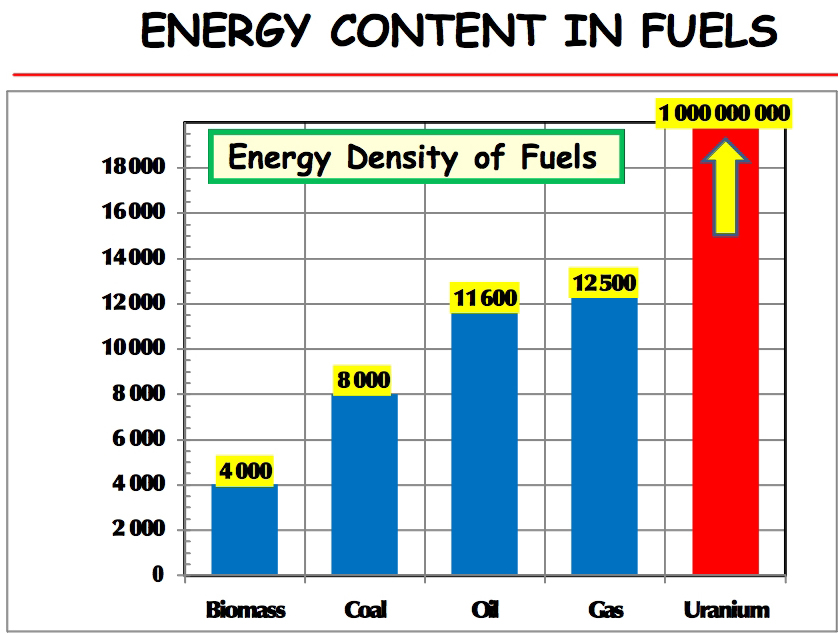 |
From this fact, I think that it is clear that we need to use this tremendous amount of density of energy. This factor of 100,000 is very important for us, because we can use very little mass from the Earth, to get the same amount of energy as burning oil: 100,000. You have to bear in mind this figure of 100,000. This simple fact will tend to say that the human being will be using nuclear energy in the future as his main source of energy.
Now if we look at world energy consumption (Figure 3), you see that there has been a tremendous increase of use of energy on the Earth, because, first, the population is increasing, but also wealth and economic growth are demanding more energy. What is important in this figure is that, through the discovery of the different forms of energy, we never leave behind other energies. There have never been substitutions of energies; we have always been adding more and more energy to what we know.
Figure 3 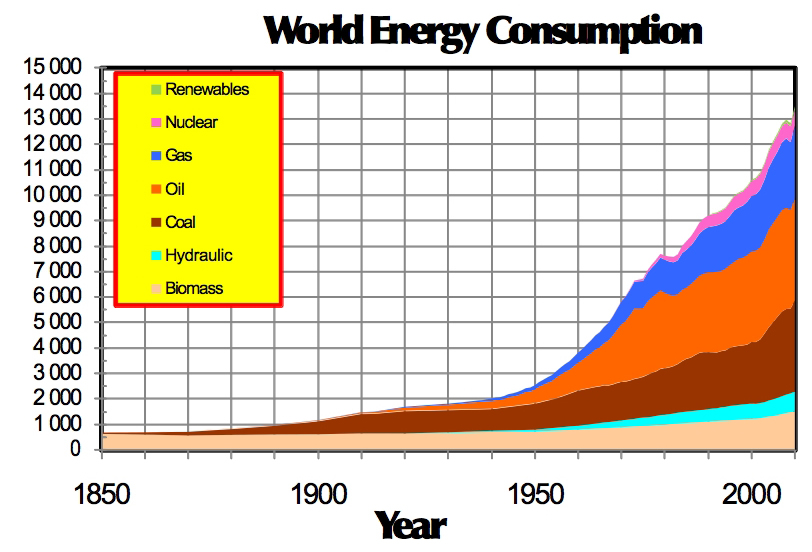 |
You see even today that biomass, which is the old use of energy by humanity, is still increasing. Coal is still increasing. Oil also. And by the way, you see that renewables here, in green, are less than 1%.
All these forms of energy are increasing, and the people are asking for more and more energy. Why? Because energy and growth are intimately linked together. We cannot get human development without energy. It is clear that if a country wants to develop, it will need enough energy per capita to develop, in order to be on the right side of the curve, which is this side of the curve-the developed countries (Figure 4).
Figure 4 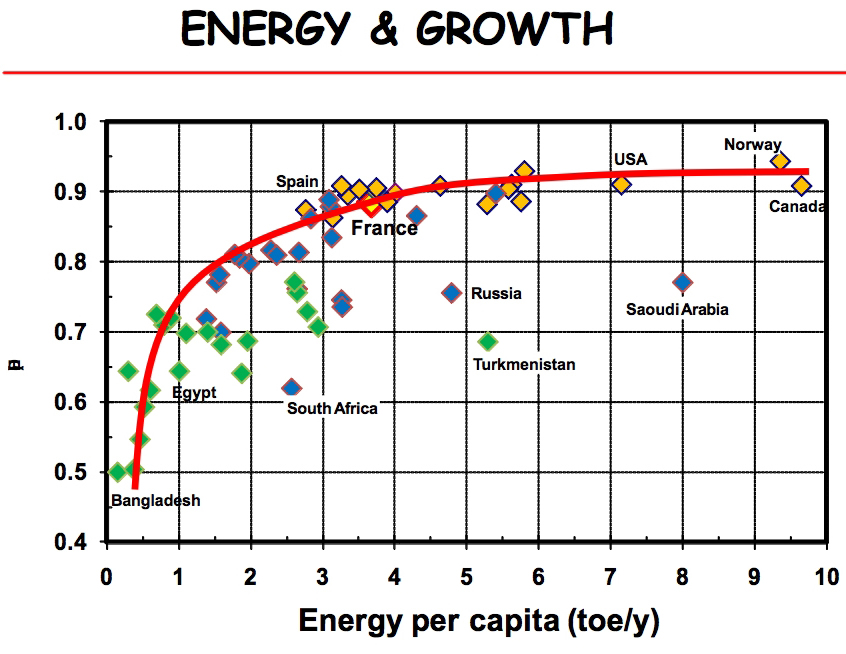 |
Many countries in the future will have to develop to the level of the wealthiest countries, and will have to have at least 4 tons of oil equivalent per capita in order to be developed enough. This means that we can foresee right now that most of the world energy consumption will continue to develop in the future.
So, if we want more energy, where can we get this energy on Earth? As you know, we have fossil fuel energy, as we have discussed just now-coal, oil, and gas; and we have renewable energy-hydraulics, wind, solar, biomass, geothermal. Most of the renewables are coming from the Sun’s radiation-except for geothermal. And we have nuclear energy, which was formed at the beginning of the formation of the Earth, 4 billion years ago, when this uranium was formed from the beginning, in the Earth’s crust.
We needed a very long time to form these fossil fuels, hundreds of millions of years. These are diffuse and intermittent energy sources. So we need something that can last sufficiently long, as resources, and we need something that is not intermittent and diffuse, but which has sufficient energy density to put out enough power.
If we look at present world resources, basically, oil and gas resources; if we add additional and proven resources, they will last probably in the hundreds of years. This means that in the next century, these will be very, very expensive, because they will be rare. We will have to go deeper into the ocean to get access to these resources.
Coal is more common, and we have much more coal on Earth than we have oil or gas. So coal will be extensively used, and it is the resource used now, especially in China; the basic resource in most countries now is coal. And if we use uranium, as we are using it today in present reactors, we only have 300 to 400 years of resources. So this means that if you want to use nuclear energy over a longer period of time, you will have to use new kinds of reactors to have enough resources to last sustainably longer than we can today.
Figure 5 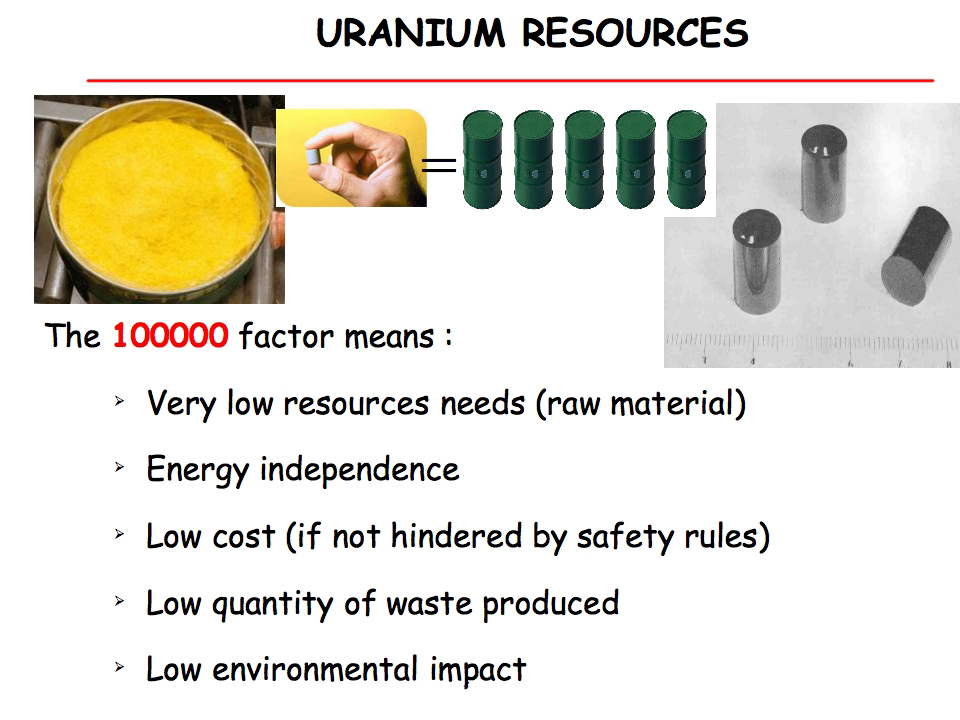 |
Just a few words about uranium resources (Figure 5): Because of this factor of 100,000 that I talked about before, this means that for the same amount of energy-this small nuclear pellet that we put in the reactor, 7 grams-is giving as much energy as 5 barrels of oil. This means that we need very, very low resources for the same amount of energy. Instead of getting billions of tons of oil, we get thousands of tons of uranium. So this factor of 100,000 is very important, from the point of view of resources that we can access on Earth.
Energy independence, low cost, low quantity of waste produced, and low environmental impact. We can get to these if we discuss more.
Prospects for the Future
What are the prospects now for the future-for the short term, and for the long term? For the short term, we have to enter a new era, where we have to modify the energy use that we are doing today. And some energy rules can really be game-changers in the energy consumption on Earth.
The first of them is energy storage-very important. Today, we do not know how to store electricity, so we have to produce electricity at the same time we consume it, and this makes for very stringent operational constraints for electricity.
The second game-changer I will talk about is recovery of wasted heat from our electricity plants, and there is plenty of heat to recover there.
The third is electric transportation; and the fourth is the longer-term sustainable energy for the future.
So, electricity storage: The only large storage-I’m talking about terrawatt-hour storage, not the small battery of your computer, which is 112 Watts. The only usable large storage is pumped storage hydroelectricity (Figure 6). When you have electricity in excess, you can pump the water in the storage to the upper part of the dam, and then, when you want to use it, you just release it by mechanical weight. And this can be done only in countries where you have mountains, of course. It’s very difficult to do elsewhere.
Figure 6 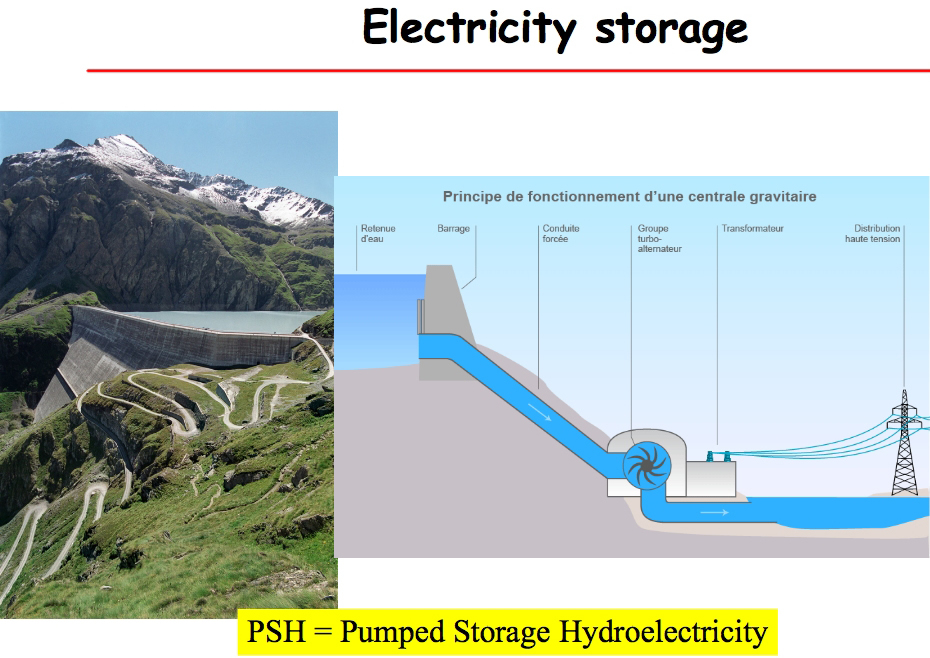 |
Other kinds of electricity storage are the compressed air storage beneath the ground; inertial wheels-where you just spin the wheels at high velocity, and then try to recover; of course, batteries; and superconducting magnetic energy storage. All these are studied in the labs. But none of these are applicable at high energy and high power.
Figure 7 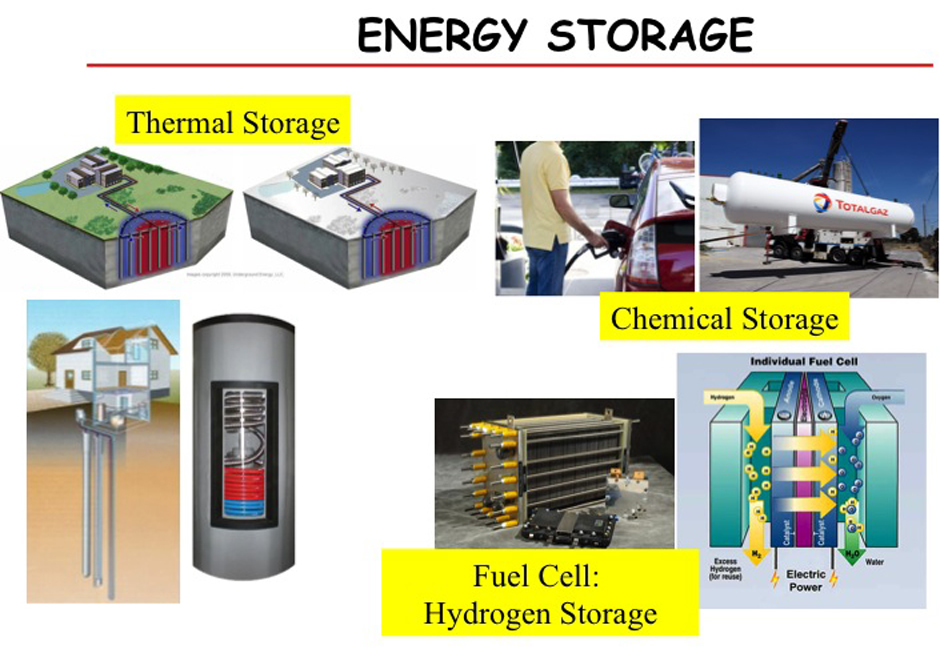 |
Other kinds of energy storage: thermal storage. Here you have a house, or a complex, where you can store energy in Summer and recover it in Winter (Figure 7). You have chemical storage-the best example is the storage in your car. And you have the fuel cell storage of hydrogen. But when you put the figures in of all these kinds of storage, what we need to do is to have enough power in this storage-this is a pumped storage hydraulic hydroelectricity. You want to be in the upper part here, in the 100 megawatts regime, and you want this storage to be not very expensive.
You see that most storage available is low power and high cost, so there is plenty of work to do to make these kinds of storage go into this range.
So this is the challenge for the next 30 years.
Recovery of Heat
The second challenge is the recovery of the heat of electrical power plants. Why is that?
Today, when you make this transformation-I told you that all we are doing is converting energy from one form to another-when you’re producing electricity at an electric power plant-here is, for example, a nuclear power plant (Figure 8)-while you’re heating the primary water in the core of the reactor, and transforming it into electrical power, only one-third of the energy released from fission is transformed into electricity. And two-thirds is just lost in the environment, heating the birds, or heating the fish. And this is not very good.
So, this is one example, our reactor in Nogent-sur-Seine (Figure 9), where you see that all this heat is going into the atmosphere. So, what can we do? What we can do is, we can make a change in the system in the secondary loop of the reactor, to recover this heat, and we can use this heat to go and heat the cities.
Figure 8 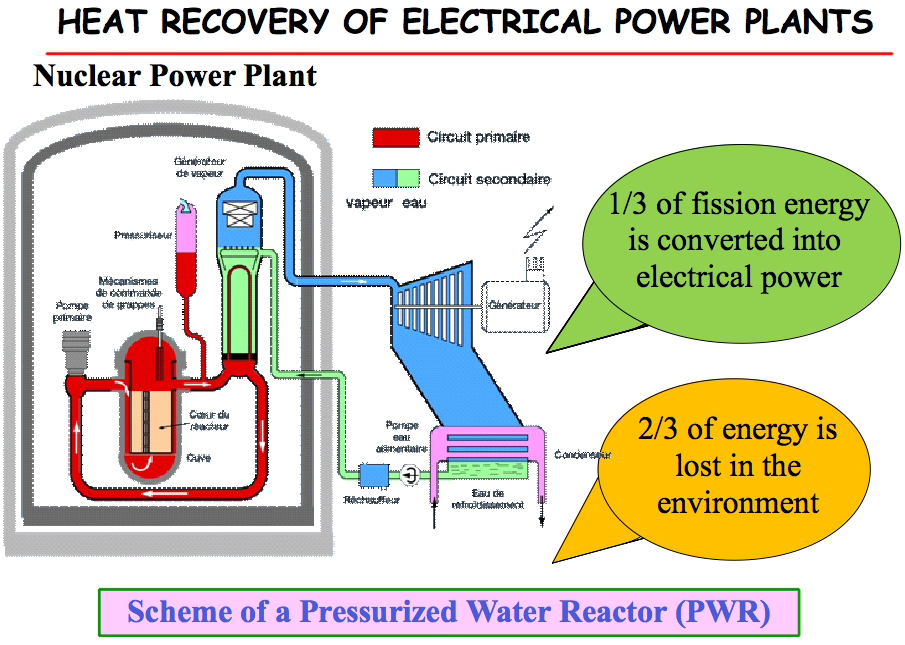 |
Figure 9 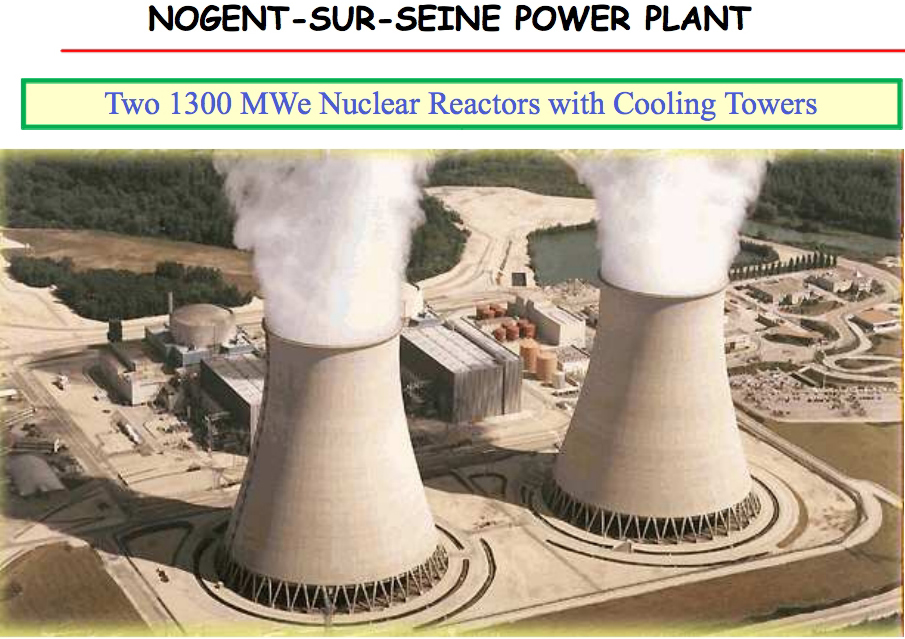 |
The problem is that the nuclear plant is ordinarily far from the cities, so the problem is how to transport heat long distances, hundreds of kilometers, from the nuclear power plant to the cities. And this can be done today with very low losses. We can have a 150-kilometer transport line with less than 2% of heat loss, and we have programs where we can try, let’s say, to recover the heat from the Nogent-sur-Seine nuclear power plant, and to try to feed it into Paris-120 kilometers away. Paris already has a heat distribution network which is the largest in France, and it has been there for almost a century. It started with trains in Gare de Lyon where we tried to heat the steam in Gare de Lyon, and it’s still there. It’s still working and, for the moment, this heat is used with coal power plants in Sant Ouen or with gas power plants. And if we can take nuclear heat, this can save a lot of energy, and a lot of money.
Transportation and Sustainability
The third challenge is the electrical transportation. Why electric transportation? What are the advantages?
If you take an internal combustion engine, you have 33% efficiency in the engine, and you have only 20% converted into motion of the car. So this means that you losing 600 watts per hour, per kilometer. If you go to an electric car, you’re only losing 200 watts of power per kilometer, because the electric engine has an efficiency of 90%. So this means that you require three times less energy for the same motion, and also, you have no CO2 emission at all.
The fourth challenge is the long-term sustainability of nuclear, and sustainability is driving the design of new reactor systems, where we are using uranium resources much more efficiently than what we are using today: 50 times more efficient.
Figure 10 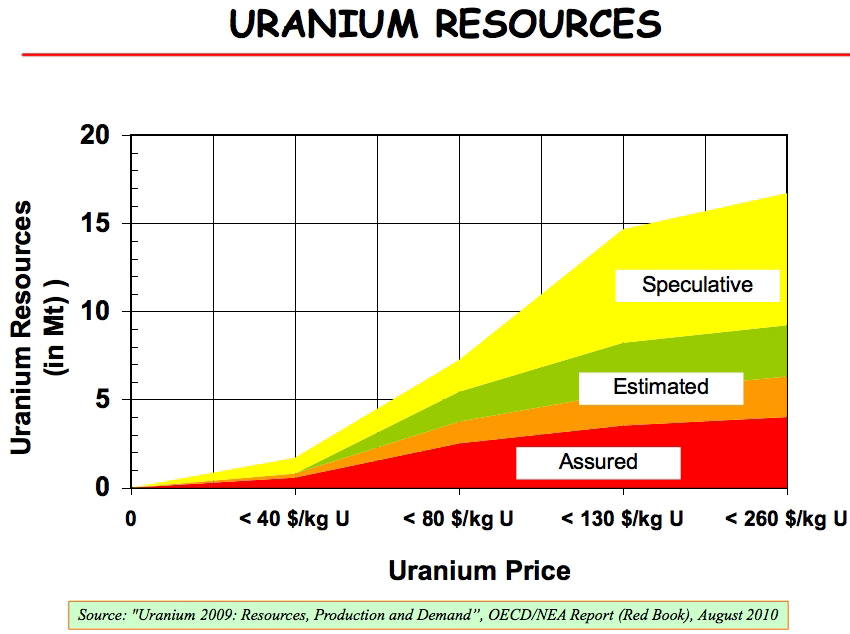 |
How do we do that? These are the uranium resources that we have today for these prices (Figure 10). And what will happen if we are using present nuclear reactors, is, we’re just consuming our uranium. And you see that in 50 years from now, we will hit our maximum resources that we have at the given price. So, we need to do something in order to move to new reactors, what we call a fast reactor. If we introduce them early, we can have enough energy from this fast reactor to last a very long, long time. When I say a long time, I mean tens of thousands of years, so it’s a much longer time scale than what we have today for our reactors.
The resource needs for fast reactors are only 8 tons of depleted uranium, as compared to 200 tons of natural uranium that you need for our present reactors. This means that the gain we can get from there is a long-term gain of sustainability for the nuclear reactor. And this, by itself, justifies developing these new nuclear reactors for the long term.
There is an International Generation IV Forum that was started in 2000, where we have selected six types of fast reactors for the future. One type is a sodium fast reactor; the others, a lead fast reactor, the gas fast reactor, the high-temperature reactor, the supercritical water reactors, and the molten salt reactors. And I think you will hear, after me, about one of these, which is the molten salt reactor.
Today, in France, essentially in the CEA, we’re working on two kinds of reactors: the sodium fast reactor, because we have a lot of experience with it-we have 30 years of experience in working with sodium fast reactors-and the gas fast reactor, which is more challenging, because it’s a helium-based fast reactor that we have never built up until now.
So these two are prototypes of the sodium fast reactor which will be built in the next 10 years in France.
In conclusion, energy density is the key issue for using a future source of energy on Earth. We need energy, of course, because we need to have economic growth. They are intimately linked. The game-changers that we see in the next 30 years are electrical storage, heat recovery from power plants, and electric transportation. And for the longer term, I would say, nuclear reactors are unavoidable.
